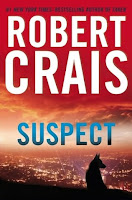First Sentence: The envelope reached Bennett Grey early
Wednesday afternoon.
There’s nothing to equal a powerful opening that contains
evocative descriptions which paint mental pictures. We feel a connection to Bennett, even though
we know nothing about him. King has
captivated us and ensured our waiting to follow along, even if it is to a
sex-scented bedroom in Paris.
Unfortunately, we also soon run into an issue which can be very
annoying. Apparently, there was a prior
book with these characters; “Touchstone”.
Without having read the first book, one feels rather lost in
understanding the character relationships.
An even greater shortcoming is that neither the back story of the
character in the prologue, nor the character himself, appears until much later
in this book. Rather than being intriguing,
it starts to leave the reader feeling lost and dissatisfied, particularly as he
is one of the most interesting characters of the book and doesn’t reappear
until nearly two-thirds of the way into the story.
Harris Stuyvesant is the primary narrator of the story and an interesting
one. He is a perfect reflection of the
period, yet not someone you always like.
He is a 1920s noir private eye, yet not so tough he is without
vulnerability and self doubt. The
relationship between Harris and Grey’s sister Sarah, and the scenes of them
together are some of the most powerful of the story.
King’s dialogue has the feel of the period. You can almost hear the narrator of a black
and white film from the period…”It’s always a shock, when someone cares more
about a thing than you do.” King adeptly
plays with the reader’s psyche. At the
same time, she is very good at conveying the persona of whosoever’s POV
controls each section of the story, and at conveying emotion…”The list was, in
fact, a ringed notebook bulging with anguish and loss.”.
King captures Paris beautifully…”Paris obscured by snow or softened
by fog, Paris adrift on fallen blossoms or carpeted in autumn leaves, Paris in
the rain, at night, the lights streaking on the pavement….” She creates a
very strong sense of place and, as the art and artists of the time--and she does include almost everyone of them who was in Paris during that time--play a
significant role to the story, her descriptions may send one to the internet to
learn more about the individuals and their art.
This also, however, becomes an issue as some of the narrative sections
become so long, the reader may start looking for the actual story wondering
where the core of the plot has gone.
I was relieved when we did get back to the story but dismayed when I identified the villain fairly early on. While the climatic scene was suspenseful and dramatic, it was also a bit over the top with shades of Edgar Allen Poe.
I was relieved when we did get back to the story but dismayed when I identified the villain fairly early on. While the climatic scene was suspenseful and dramatic, it was also a bit over the top with shades of Edgar Allen Poe.
“The Bones of Paris” has some great
strengths but also some painful weaknesses.
It is an interesting book and one I never considered putting down. Yet, I can’t help but wonder whether a much
stronger editor would have solves some of the issues and made it a much better
book. Please, authors, do use and listen to your editors. It’s unfortunately, as Ms. King is
a very good writer and her book “Folly” will always remain as one of my
favorites.
THE
BONES OF PARIS (Hist Mys/Susp-Harris Stuyvesant-Paris-1929) – Okay
King, Laurie R.
Bantam, 2013












